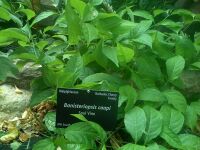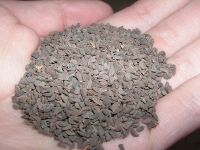Harmala alkaloid
Harmala alkaloids are a group of psychoactive alkaloids found primarily within the seeds of Peganum harmala, also known as syrian rue. These alkaloids are of interest for their use in Amazonian shamanism, where they are derived from plants. Harmala alkaloids are naturally occurring beta-carboline alkaloids that are structurally related to harmaline, and also found in the vine Banisteriopsis caapi. They also occur in tobacco, and contribute to its subjective effects, but not to its addictiveness (which is instead caused by the presence of nicotine), and in more negligible amounts than in Peganum Harmala and Banisteriopsis cappi.
Chemistry
Harmala alkaloids are substituted derivatives of the molecule beta-carboline. The structure of beta-carboline is comprised of an indole skeleton fused to a pyridine ring. Harmine, harmaline, and tetrahydroharmine share structural substitutions and they all contain a methoxy group at R7 and a methyl group at R1. They differ in the saturation of their six-member nitrogenous ring. Harmine contains an unsaturated pyridine ring while harmaline contains a dihydrogenated pyridine ring. Tetrahydroharmine is saturated with four additional hydrogen bonds than harmine.
Pharmacology
Harmala alkaloids are classed as MAOIs. This means that they inhibit the activity of monoamine oxidase metabolic enzymes, of which two varieties exist: MAO-A and MAO-B. The alkaloids bind reversibly to the active site of the enzyme, inhibiting its endogenous function of destroying amine functions of neurotransmitters and externally administered centrally active drugs. This has the effect of potentiating and prolonging the central and peripheral activity of both neurotransmitters and a variety of drugs. They are reversible MAOIs of the MAO-A isoform of the enzyme, and can stimulate the central nervous system by inhibiting the metabolism of monoamine compounds such as serotonin and norepinephrine.
Harmala alkaloids are selective for MAO-A at reasonable doses and bind to the enzyme temporarily, so they are classed as a reversible inhibitor of monoamine-A (RIMA). At higher doses, they also affect the MAO-B enzyme. Because of the reversible selectivity for MAO-A, harmala alkaloids are considered to be less dangerous when combined with food containing tyramine and other substances with monoamine moieties which are reliant on monoamine oxidase for decomposition.
However, it is important to understand that this does not imply that harmala alkaloids will not cause neurotoxicity. Harmala alkaloids temporarily disable the brain's primary mechanism for breaking down neurotransmitters and drugs which can have negative consequences as material builds up in the synapses, leading to a huge range of downstream central and peripheral effects including sedation, stimulation, anxiety, cognitive dysphoria, euphoria, headaches, eye strain, and muscle convulsions. The harmala alkaloids are not especially psychedelic, even at higher dosages, when hypnagogic visions, alongside vomiting and diarrhea, become the main effect.
Since DMT is broken down by monoamine oxidase A, inhibition of this enzyme allows for the oral activation of DMT and prolongs the experience for the duration of the harmala alkaloid effects. In combination, harmala alkaloids and DMT are known as ayahuasca.
Harmala alkaloids, along with other beta-carbolines, also function as GABA-A receptor (benzodiazepine site) inverse agonists, likely contributing to their anxiogenic and convulsant effects.[1]
Examples
Common harmala alkaloids include:
Harmane
Harmane (harman) is a MAO-A inhibitor.[2][3]
Harmine
Harmine is a reversible inhibitor of MAO-A (RIMA) Threshold: ~30mg Light: 30-80mg Common: 80-130mg High: 130-180mg Strong: 180mg+
Harmaline
Harmaline is a reversible inhibitor of MAO-A (RIMA) Threshold: ~40mg Light: 40-90mg Common: 90-140mg High: 140-190mg Strong: 190mg+
Tetrahydroharmine (THH)
L-Tetrahydroharmine does not inhibit monoamine oxidase A. Instead, it weakly inhibits reuptake of serotonin.
D-THH, on the other hand, has similar potency in terms of inhibiting MAO as harmine.
Subjective effects
The effects listed below are based upon the subjective effects index and personal experiences of PsychonautWiki contributors.
Physical effects 
-
The physical effects of harmala alkaloids are usually described as uncomfortable, especially in high doses.
- Abnormal heartbeat
- Appetite suppression
- Changes in gravity
- Diarrhea - This occurs mostly in high doses and when the seeds are consumed without extraction.
- Dizziness
- Increased heart rate
- Nausea
- Pupil dilation
- Increased salivation
- Vasodilation
Visual effects 
Cognitive effects 
Auditory effects 
-
- Distortions - Ringing ears is commonly experienced on harmala alkaloids.
Experience reports
Anecdotal reports which describe the effects of this compound within our experience index include:
- Experience:2 grams Psilocybe Cubensis + 2.7 grams Syrian Rue - The Psilohuasca Albino Fox
- Experience:2.5g Peganum Harmala + 250µg LSD - Ecstasy of Love and Misanthropy
- Experience:40mg + Syrian Rue (unknown dosage) - My one bad trip
- Experience:40mg + Syrian rue (3g) - My triumphant return
Additional experience reports can be found here:
Natural sources
Banisteriopsis caapi
Banisteriopsis caapi (also known as ayahuasca, caapi or yajé) is a South American jungle vine of the family Malpighiaceae. It contains harmine, harmaline, and tetrahydroharmine in the following proportions:
- Harmine: 0.31-8.43%
- Harmaline: 0.03-0.83%
- Proanthocyanidins (less known MAOIs)
- (−)-epicatechin
- (−)-procyanidins
- Tetrahydroharmine: 0.05-2.94%
Peganum harmala (Syrian rue)
Peganum harmala, commonly called esfand (native name), syrian rue, is a plant native to the eastern Iranian region west to India. It has also spread invasively throughout Arizona, California, Montana, Nevada, Oregon, Texas and Washington. The plant itself produces seeds which contain harmala alkaloids and is easily accessible and legal to purchase online through the use of google. Powdered syrian rue seeds act as a reversible inhibitor of MAO-A (RIMA) at doses of 2 - 5g.
Syrian rue seeds contain several different harmala alkaloids at slightly varying percentages. Only some are monoamine oxidase A inhibitors. In one study, total harmala alkaloids were at least 5.9% of dried weight.
| Beta-carboline[4] | Content |
|---|---|
| 1-hydroxy-7-methoxy-β-carboline | |
| 2-aldehyde-tetrahydroharmine | |
| 3-hydroxylated harmine | |
| 6-methoxytetrahydro-1-norharmanone | |
| 8-hydroxy-harmine | |
| Acetylnorharmine | |
| Desoxypeganine[5] | |
| Dihydroruine | |
| Dipegene | |
| Harmalacidine (HMC) | |
| Harmalacinine | |
| Harmalanine | |
| Harmalicine | |
| Harmalidine | |
| Harmaline (dihydroharmine, DHH, harmidine) | 0.25%[6]–0.79%[7]–5.6%[8] |
| Harmalol | 0.6%[8]–3.90%[6] |
| Harmane (harman) | 0.16%[6] |
| Harmic acid | |
| Harmic acid methyl ester | |
| Harmine (banisterine, telepathinec, yageine) | 0.44%[7]–1.84%[6]–4.3%[8] – The coatings of the seeds are said to contain large amounts of harmine.[9] |
| Harmine N-oxide | |
| Harmol | |
| Isoharmine | |
| Isopeganine | |
| Norharman | |
| Norharmine (tetrahydro-beta-carboline) | |
| Pegaharmine A | |
| Pegaharmine B | |
| Pegaharmine C | |
| Pegaharmine D | |
| Pegaharmine E | |
| Pegaharmine F | |
| Pegaharmine G | |
| Pegaharmine H | |
| Pegaharmine I | |
| Pegaharmine J | |
| Pegaharmine K | |
| Peganine A | |
| Peganine B | |
| Peganumal A | |
| Peganumal B | |
| Peganumine A | |
| Peganumine B | |
| Ruine | |
| Tetrahydroharman | |
| Tetrahydroharmine (THH, leptaflorine) | 0.1%[8] |
| Tetrahydroharmol | |
| Tetrahydronorharman |
Extraction
Though ground seeds can be consumed raw, this is an unreliable method of accessing the contained harmala alkaloids. The stomach can only soak the seed material in gastric juice for a limited period before it is moved further along the digestive system for absorption of molecules in solution. Because of this, whole seeds are ineffective; ground or pulverized seeds work in some circumstances, but to reliably and predictably achieve psychoactivity, it is most efficient to first extract the alkaloids from the seeds of peganum harmala into a solution by brewing it for at least 30 minutes.
The brewing environment can be enhanced by acidifying the water, using stronger solvents, and increasing the temperature. Using more water will also increase the concentration gradient, allowing more alkaloids to dissolve.
Toxicity and harm potential

See the MAOI page for substances that may cause dangerous interaction.
Drug interactions
MAOIs have highly dangerous and sometimes fatal interactions with many common drugs. They can cause serotonin syndrome or hypertensive crisis when combined with almost any antidepressant, stimulant, common migraine medication, certain herbs, most cold medicine (including decongestants, antihistamines, and cough syrup), nicotine, caffeine, etc. Sedatives are likely easier tolerated, but potentiation should be expected.
Cholinergics
Acetylcholinesterase inhibitors (AChEIs) combined with cholinergic substances can result in a cholinergic crisis.
Banisteriopsis caapi and Peganum harmala contain harmaline and harmine. Both alkaloids are acetylcholinesterase inhibitors (AChEIs).[10]
Lethal dosage
When intravenously injected into mice, the LD50 of harmine is 38mg/kg. There is no data for the other harmala alkaloids in humans or animals.
It is strongly recommended that one use harm reduction practices when using this drug.
Tolerance and addiction potential
There is no tolerance built up with harmala alkaloid use. There are no real reports of addiction to harmala alkaloids.
Legal status
Harmala alkaloids and their natural sources are legal in most parts of the world.
- Australia: Harmala alkaloids are Schedule 9 drugs under POISONS STANDARD of DECEMBER 2019. HARMALA ALKALOIDS except in herbs, or preparations, for therapeutic use:
- containing 0.1 per cent or less of harmala alkaloids; or
- in divided preparations containing 2 mg or less of harmala alkaloids per recommended daily dose.
- Canada: Harmala alkaloids are Schedule III drugs.
- France: Possession and sale of harmala alkaloids is illegal.
See also
External links
- Harmala alkaloids
- Natural sources
Literature
- Morales-García, J. A., de la Fuente Revenga, M., Alonso-Gil, S., Rodríguez-Franco, M. I., Feilding, A., Perez-Castillo, A., & Riba, J. (2017). The alkaloids of Banisteriopsis caapi, the plant source of the Amazonian hallucinogen Ayahuasca, stimulate adult neurogenesis in vitro. Scientific Reports, 7(1), 5309. https://doi.org/10.1038/s41598-017-05407-9
References
- ↑ Venault, P., Chapouthier, G. (19 February 2007). "From the behavioral pharmacology of beta-carbolines to seizures, anxiety, and memory". TheScientificWorldJournal. 7: 204–223. doi:10.1100/tsw.2007.48. ISSN 1537-744X.
- ↑ https://www.frontiersin.org/articles/10.3389/fnmol.2022.925272/full
- ↑ Herraiz, T; Chaparro, C (18 January 2006). "Human monoamine oxidase enzyme inhibition by coffee and beta-carbolines norharman and harman isolated from coffee". Life sciences. 78 (8): 795–802. doi:10.1016/j.lfs.2005.05.074. PMID 16139309.
- ↑ "Table 4 | Peganum spp.: A Comprehensive Review on Bioactivities and Health-Enhancing Effects and Their Potential for the Formulation of Functional Foods and Pharmaceutical Drugs". www.hindawi.com.
- ↑ Algorta, J; Pena, MA; Maraschiello, C; Alvarez-González, A; Maruhn, D; Windisch, M; Mucke, HA (March 2008). "Phase I clinical trial with desoxypeganine, a new cholinesterase and selective MAO-A inhibitor: tolerance and pharmacokinetics study of escalating single oral doses". Methods and findings in experimental and clinical pharmacology. 30 (2): 141–7. doi:10.1358/mf.2008.30.2.1159649. PMID 18560630.
- ↑ 6.0 6.1 6.2 6.3 Hemmateenejad B, Abbaspour A, Maghami H, Miri R, Panjehshahin MR (August 2006). "Partial least squares-based multivariate spectral calibration method for simultaneous determination of beta-carboline derivatives in Peganum harmala seed extracts". Anal. Chim. Acta. 575 (2): 290–9. doi:10.1016/j.aca.2006.05.093. PMID 17723604.
- ↑ 7.0 7.1 Pulpati H, Biradar YS, Rajani M (2008). "High-performance thin-layer chromatography densitometric method for the quantification of harmine, harmaline, vasicine, and vasicinone in Peganum harmala". J AOAC Int. 91 (5): 1179–85. doi:10.1093/jaoac/91.5.1179
 . PMID 18980138.
. PMID 18980138.
- ↑ 8.0 8.1 8.2 8.3 Herraiz T, González D, Ancín-Azpilicueta C, Arán VJ, Guillén H (March 2010). "beta-Carboline alkaloids in Peganum harmala and inhibition of human monoamine oxidase (MAO)". Food Chem. Toxicol. 48 (3): 839–45. doi:10.1016/j.fct.2009.12.019. PMID 20036304.
- ↑ "African rue or Harmel". cdfa.ca.gov. Archived from the original on 22 October 2015. Retrieved 17 February 2021.
- ↑ Zheng, X., Zhang, Z., Chou, G., Wu, T., Cheng, X., Wang, C., Wang, Z. (September 2009). "Acetylcholinesterase inhibitive activity-guided isolation of two new alkaloids from seeds of Peganum nigellastrum Bunge by an in vitro TLC- bioautographic assay". Archives of Pharmacal Research. 32 (9): 1245–1251. doi:10.1007/s12272-009-1910-x. ISSN 0253-6269.


